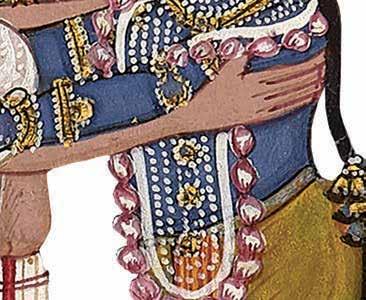
4 minute read
collector’s note
rt’ and ‘Nathdwara’ are two consistently recurring themes in my life. Somehow, both of them creep up in mysterious ways, leaving me in delight and curiosity. Together they generate a certain energy and response which make me want to know more or to experience something important in my life.
I have always liked collecting portraits and miniature paintings of the Nathdwara School. It was during one of my trips to acquire some portraits that I encountered manorath paintings. These works immediately attracted my attention due to their unusual visual elements, especially their photorealistic portraits. Most of these paintings were originally part of Pushti Marg popular culture and, therefore, they were not necessarily given much importance by scholars. Such paintings were commissioned by Pushti Marg devotees to keep an indelible record of a pilgrimage trip to Nathdwara. However, they were later disposed by their successive owners to find a new life with scrap dealers, antique sellers or at flea markets.
Advertisement
In 2002, after collecting a considerable number of works encompassing the wide variety of artistic genres produced at Nathdwara, I decided to exhibit them. I reached out to Amit Ambalal, who handpicked the paintings from my collection and identified the underlying theme for the exhibition. Together we curated a show titled ‘Tasveer–How Camera Influenced Indian Portraiture’, which included a couple of manorath paintings.
The process of collecting manorath paintings has led to a number of interesting anecdotes. A surprising incident happened in 2015, when I displayed a few manoraths from my collection in the ‘Indian Portrait–VII’ exhibition. During the show, a seventyseven-year-old lady from Ahmedabad recognized her parents and herself in one of the manorath paintings on display (Cat. no. 28). She shared with me how they were frequent visitors to Nathdwara. During one of the trips, when she was eight years old, they went to an artist’s studio to commission that particular work. The artist took a photograph of them which was used to produce the painting. The work was probably made to be donated to an institution to which her father was contributing as a wealthy philanthropist. In fact, she admitted, she never saw it in her house. Years later, I found that work through a scrap dealer and acquired it.
Through my experience, I have learnt that art can vivify our encounters in life, record them, examine them, reshape them, and finally, leave a trace that can be shared by others. Thus, I have always liked to reconstruct the history of Nathdwara painting through personal stories. I always get a thrill whenever I can identify the priests, nobles, or devotees portrayed in the paintings. One such incident occurred when I came across a manorath painting inscribed to the famous Nathdwara artist Champalal Hiralal (Cat. no. 5). I got immediately intrigued by it, not simply for its subject but because the devotee looked very familiar. It felt as if I knew that person and his face. Later on, going through my collection of sketches and drawings, I found a study of his portrait and immediately recognized the subject (Fig. 6). I was as elated as if I had met some acquaintance of mine after a long time.
In 2014, Isabella Nardi visited Ahmedabad while on her way to Jhalawar. At that time, she was researching the murals of the Garh-Mahal, many of which were executed by Nathdwara artists, including the famous Ghasiram. This is when I invited her to see my collection and I recounted to her my tryst with Nathdwara. After seeing my manorath paintings, she became instantly drawn to the subject and started exploring them more closely. A year later, she shared with me some of her findings which brought to the fore a story that needed to be told. In order to answer some of the new questions that emerged from her preliminary research, I decided to visit Nathdwara on numerous occasions to dialogue with some esteemed traditional artists and their families, including the relatives of Khubiram and Gopilal. This is how our vision on manorath painting expanded, leading to this catalogue which presents new discoveries on this intriguing devotional genre.
The collection in this catalogue is a way of seeing the world, a way of expression, and a way of bringing to the fore the latent. It is evident from these paintings that art equals life and life equals art.
Anil Relia Ahmedabad, January 2019












